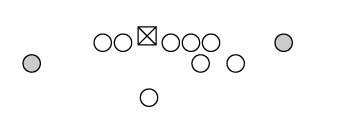A Misguided Decision to Change
October 25th, 2004
After three years of running the single wing successfully, I succumbed to pressure from the local high school coach and some of the officers in our youth football association and agreed to run a quarterback based Wing-T. The high school had committed to running the inside belly series (a.k.a. double dive option) as the basis of their offense and had convinced many in our organization that it was our duty to our community to develop quarterbacks to feed the coming dynasty.
The pressure had been fairly intense. When the high school coach was re-hired before the 2001 season, I was really happy about it. He had won a state championship here in 1992. He was one of the top 50 winningest high school football coaches in the state’s history. He had been coaching at another school just across the state line and had taken them to within one point of the state championship game running a single wing offense.
I had made the decision to run the single wing beginning with the 2001 season. The prospect of having the local high school running the single wing also was very exciting. When I met with him to discuss my plans for the season, he told me that the single wing was the wrong thing to do. He said the single wing was a good offense but he had no plans to run it because if it failed you got fired. I told him that I had the perfect team to run the single wing that season and that I had already made a final decision. He wasn’t happy.
Our 2000 team went 10-0, won the league championship and established a new league scoring record, averaging a point-a-minute. Funny thing, the high school ran the single wing about 25% of the time that season. Nevertheless, the high school coach saw fit to publicly bitch at me about failing to develop quarterbacks for the high school. In 2002, our team went 9-1, won the league championship and broke our own league scoring record, averaging 38 points per game. The high school increased their single wing usage to about 50% that season. Nevertheless, after one of our most impressive victories, the high school coach saw fit to dress me down about failing to develop quarterbacks and failing to keep enough 8th graders in our program. In 2003, we had a very slow team, but we averaged 25 points per game and made it to the semi-finals, finishing with a 6-3 record. Like Chico Escuela, the single wing “bin berry, berry good to me”.
I helped a lot of other coaches install it and for the most part they were successful as well. I had the great honor and privilege of giving the youth league presentation at the 2004 Single Wing Symposium. The high school quit using the single wing at all in 2003 and committed totally to the inside belly for 2004 and beyond. In a preseason meeting for our coaches, the high school coach sent his defensive coordinator to appeal to us to run inside belly and develop quarterbacks. The guys running our organization told him that sounded reasonable so I reluctantly agreed.
I will admit to some selfish motives in agreeing:
1. The group of 13 year olds I was inheriting had never won at any level. I was concerned that they were bad enough to even make the single wing look bad.
2. I had seen a small high school from downstate that ran buck sweep and what appeared to be a pre-determined inside belly. This school holds many of the state’s all-time rushing and scoring records. I thought it would be neat to try to imitate them.
3. Our schedule was going to be brutal.
I discovered after a short while in preseason practices that we were going to have some problems. Our team was absolutely puny and not very athletic. We had 28 players, but most of them were really B-teamers. Our pulling guards didn’t have great speed and apparently I wasn’t very good at coaching quarterbacks. Our backs didn’t run with authority and were always coming out of the game with little owies. We put together some drives early in the season, but they invariably self-destructed deep in enemy territory. We got throttled badly by superior teams in our first 2 games. Before the 3rd game, I arranged for a B-team exhibition game for our backups. We won 20-13. In our third A-team game we lost a game we should’ve won because our quarterback got injured in the first half and our backups weren’t really ready to take over. We committed 3 second half turnovers and lost 25-16. The following week, we got crushed again by a superior team, but we won another B-team game with our backups 13-12. We blew another game against a mediocre team the following week on turnovers 30-18.
Then came a turning point. We had another backup game scheduled for a Saturday, but our second string quarterback was out of town, our third string quarterback broke his collarbone and our fourth string quarterback had oral surgery that Friday. I couldn’t think of another option, so we put in a really basic 5-play single wing offense in 15 minutes before the start of the game. This was the best B-team opponent of the 3, but we crushed them 30-0. Our 74 LB. tailback rushed for about 180 yards and threw a touchdown pass and our 85 LB. fullback added about 70 yards rushing.
I started to get the feelings that I’d had in the games of 2001 and 2002. My mind always seemed to be one or two steps ahead of the opposing defensive coordinator. They could not stop us. We would never punt. We’d pound the strong side, wedge the middle, counter the weak side and throw play action over the top. Whenever they adjusted, we had the appropriate counterstroke. The next day it was back to the Wing-T, as our A-team got absolutely crushed by a mediocre team 37-14. At one point in the game I heard the opposing defensive coordinator warn his players to watch out for the exact play I had called. Then it kept happening for 3 plays in a row.
That was it. I couldn’t take any more of this humiliation. Our A-team was 0-6. We were going to run the single wing in the final regular season game and that was that. So we worked on it in practice and put in about 6 plays. Then, in Thursday night’s practice, our “star” running back broke his finger. By Saturday, I’d been informed that he wasn’t playing because he was a baseball pitcher and he needed to have pins put in the finger. So I moved our 85 LB. B-team fullback to starting halfback/single wing fullback. Result: We overcame 3 turnovers and an 18-13 halftime deficit to win 25-18. You could see the players start to feel the single wing mojo.
I was much more confident in what we were doing and so were the players. The backs that looked like deer in headlights in the Wing-T were starting to run hard. The line actually started executing every so often. We finished our drives in the end zone, instead of getting stopped on downs at the 10. The following week we traveled for the opening game of the consolation playoffs. It was a bit embarrassing for a coach who had won 2 Super Bowls to be competing for the right to play in the “Toilet Bowl”, but that’s the way things worked out. For this game we actually had a semi-polished single wing. After all we’d had 2 whole weeks to practice it. Our tailback (formerly our prima donna quarterback) started the game with a 40-yard sweep for a touchdown. After that, the game was about our little fullback running wedge plays for a total of 100 yards. The scrubs went in early and the clock wound fast in the slaughter rule as we won 44-6. The next week we won 12-0, though we could easily have scored much more. We took a knee on their 1-yard line after a 94-yard drive, which ate up the entire 4th quarter. Earlier in the game we drove to their 2-yard line before penalties stopped us and on another drive we fumbled at their 15-yard line. We racked up over 250 yards rushing with 6 different backs (including 2 blocking backs) gaining over 30 yards each in the game.
As I write this, the local high school team is 1-7 and my team is preparing to play in the league’s “Consolation Bowl” finals. Win or lose, we’ll accept a huge trophy and gaudy medals for our 4-6 or 3-7 record. My players and their parents will be delirious with joy. I’ll be happy for them, but in a way I’ll be happier for me. Because this season has taught me perhaps the most valuable lesson of my coaching career, as Shakespeare put it, “This above all: to thine own self be true, And it must follow, as the night the day, Thou canst not then be false to any man”. In my case, being true to myself as a football coach will always be running the single wing.
Note: I have to give some credit to John Carbon for our team’s turnaround this season. After our 5th loss, I gave our defensive coordinator a copy of John’s “Jaws of Death Defense”, a hybrid of the split 6 and wide tackle 6. We started using this defense the same week we started running the single wing (week 7). We gave up about 30 points a game through the first 6 games, but only 8 points a game over the last 3 games.
Eric Strutz
eric.strutz at ge dot com
Single Wing With Double Wing Principles
October 18th, 2004
I am a double wing coach who once ran the single wing to the tune of 38 points per game and a 13-1 overall record. 38 points per game is better than “a point a minute” in our games! Unfortunately, being a junior high coach, I was told that I had to scrap the single wing because we “weren’t developing a quarterback”. Because I wanted to stick with the same concepts of maximum power, misdirection, double teams, traps, pulling linemen and WINNING football games, the double wing was the next best thing.

Indirect Snap Double Wing Base Formation
However, now as a double wing coach with a single wing background I find that I can’t leave the single wing alone. After having my best runner (my double wing fullback) taken out of the game plan by submarining defensive linemen, I have added my Rhino and Lion formations to my double wing offense. What I do, is let my quarterback slide over into the B gap and assume the kick out blocks, my “A back” slides over behind the quarterback about 3 yards deep and my fullback moves 4 yards deep behind the center. He is my toughest and fastest player. Perfect for a single wing tailback. My right wing back is my best blocker of the two wings.

Direct Snap Rhino Formation
That’s right, we now shift into direct snap formations so that my best runner can now run blasts, powers both strong and weak and power sweeps. This does not require any change in blocking schemes for the big guys up front. I was able to install this in a single practice and can’t wait to unleash this attack against the next diving and submarining foe. They won’t know what hit them when we shift back to our killer single wing!
For those interested, what are some advantages of the single wing over the double wing? Well, I think I can have just one good runner to make the single wing go which I do not think I can do with the double wing. The backfield actions require significantly less coaching. There are fewer timing issues. Additionally, I feel the blocking back in the single wing has a better angle than I could give my double wing fullback even though he, too, is incredibly tight and hidden. Finally I think the ability of the linemen to pull without banging into a quarterback and possibly causing a fumble is reason to rejoice. The single wing gives me confidence that we can still move the ball with our bread and butter plays (powers, blasts, counters, traps and sweeps) even if our quarterback were to be injured. Both offenses are powerful and fun and in my opinion, POETRY IN MOTION.
Steve Calande
coachcalande at comcast dot net
Historical Perspective: Early Coaching Legends
October 11th, 2004
This week’s Direct Snap topic is about the interesting coaching characters found on the college gridiron during college football’s Golden Era of the 1920s and 1930s. There were as many “flavors” of direct snap offenses as there were coaches. Today’s article will touch on five of those men. For the first four coaches I pulled excerpts from the book, Great College Football Coaches of the Twenties and Thirties by Tim Cohane, New Rochelle, N.Y., Arlington House [1973]. The article focusing on Gil Dobie is written by Ted Seay. Enjoy.
Snap & Go!
Adam
adam_wesoloski at yahoo.com
Dick Harlow
“Do It My Way, Dear Boy”
Harlow’s offense at Harvard and before that at Western Maryland was a form of single wing constructed to compensate through timing and deception for the lack of power. He and Carl Snavely, at Cornell and North Carolina, led the way in developing a series of single wing plays with fullback spins, reverses, double reverses, traps, and angle blocking. It was really double wing football from single wing. It got results by keeping the defense unsure an extra split second as to who had the ball and was heading where.
Howard Harding Jones
The Thunder Maker
Offensively, Jones used an unbalanced line with the two guards lining up shoulder to shoulder on the strong side. The guard nearest the center pulled out to run interference. The objective of Jones on his end sweeps and off-tackle thrusts was to get three blockers ahead of the runner at the point of play impact, and nobody ever succeeded any better, if as well.
The tailback or the fullback did all the ball carrying except on reverses. There was a single reverse in which the left end, shifting back into a wingback position, took the ball. On the double reverse, he faked to take the ball and it was handed to the blocking back moving in the opposite direction…
…”More than 60 percent of our total practice time,” said Joe Shell, 1939 captain, “was involved with purely fundamental blocking and tackling.”
Robert Neyland
The Gridiron Brigadier
Offensively, Neyland used a single wing balanced line that fused part of the Notre Dame box and some of Gil Dobie’s off-tackle mechanics. On old No. 10, Tennessee’s off-tackle play, the end and the tackle teamed on the tackle, the fullback and the quarterback teamed on the end, and the two guards pulled to lead the play. Tennessee’s toughest-to-defend-against play, as with other formations was the option run or pass by the tailback, depending on the commitment made by the defensive left halfback…
…”I was not wedded to the single wing as closely as some thought,” he mused. “I used it because we could get quicker power at tackle.”
Jock Sutherland
Overland Man
…In a era when the punt on third down or earlier deep in one’s own territory was dominant, Pitt kicked only on fourth down, regardless of field position, because Jock wanted to keep the ball as long as possible. Naturally, with that running game. He was unorthodox also in having his center not snap the ball in spiral but flip it end over end. “I don’t have the time to teach the spiral,” he claimed. Actually, he felt the spiral snap was more likely to be fumbled, and that it put needless pressure on his center.
Gil Dobie
This is one of the two men (along with Warner, of course) who has a plausible claim to inventing the single wing.
In his nine seasons at Washington, Gil Dobie never lost a game! He compiled a ridiculous record of 58-0-3, which transpired into a streak of 63 consecutive games without a defeat. This is an NCAA record which still stands.
He was also a character of legendary proportions. He was the most gruff and terse human being you’d ever meet. He was despised by those on the upper campus, often pelted by peanuts thrown by Washington’s own fans, and once had to be separated from a near fist fight with the mayor of Seattle.
His first practice was remembered by a player: “No smile, no handshakes, no slap on the back –- nothing but a pair of eyes peering coldly out of a dark face that was hidden partially by a slouch hat drawn loosely over a head of mussed black hair. He began to unfold himself from a lounging position. He seemed to mount into sections until his six feet and more of black overcoat had assumed an upright position. Those eyes were still working on us…”
In Dobie’s nine years with the Purple and Gold, his teams outscored opponents 1,930 to 118, and recorded 26 shutouts. They threw the ball only a half-dozen times a game, but would instead focus on smash runs. Dobie demanded precision, and would often spend an entire practice devoted to running the same play over and over again, until choreographed into perfection.
Among his noted players was quarterback Willie Coyle, a four-year starter. Coyle never lost a game, and yet in 1974 as an old man recalled the words Dobie had for him his senior year. The “encouragement” came at the end of a Friday night strategy meeting, in a tiny room filled with smoke and his gruff coach peering across at him with his trademark tombstone glare. “Coyle, you’re a rotten quarterback and if I didn’t have so many cripples you’d be sitting on the bench. You’ve played your last two games like a man devoid of brains.”
Coyle’s career record as a starter was 26-0-1.
My personal favorite Dobie story concerns a tackle who broke training in public — eating fudge at a sorority shindig. Word got back to Dobie, who preceded to run this kid into the ground the next day at practice, until he was heaving chocolate chunks. Dobie roared at him, “You WILL break training, you fudge-eating %##$!!!”
Style — you’re either born with it, or you aren’t…
It’s the Spin That Wins!
Ted Seay
seayee at hotmail dot com
Formationing from the Single Wing
October 4th, 2004
By John Carbon
jcarbon at yahoo dot com
Formationing is one of the most important strategies employed by todays football coaches. The ability to “hit them where they ain’t” is more important than any form of trickery. In fact it is much simpler than to install and apply since it only involves changes in positions by one or two players on offense.
The great Homer Smith once said “It is up to coaches to put their players into relationships with defenders that will help them win.” I like the fact that I can run off defenders with simple formation adjustments. This allows me to target defenders and make the most of mismatches.
I am a Dr. Keuffel follower so I like to run the straight series. We base all our plays around a core formation. The core is the following:

Out of this formation we will then move the strong end out or move the fullback to a slot/flanker position. In many cases we will replace the fullback with a wide receiver type. We make sure that all formations we use let us run our bread and butter plays. As with most single wing coaches we run wedge, seam buck, sweep, off-tackle, wingback reverse and sweep pass.
We always start the game in the traditional unbalanced single wing. We will start formationing as soon as we can identify a opponents weakness on defense. This can be as simple as running away from a stud defender to finding a mismatch between a a corner back and one of our speedy receivers.
Here are the seven formations that we are using at this time.
1. Single Wing Base
2. Yale
3. Twins
4. Trips
5. Pro
6. Reed Right
7. Reed Left
While the Yale formation and tight single wing formation have obvious advantages I would like to go over the other formations advantages.


Let’s start with Twins.

The first advantage is the quicker corner for the off-tackle play. It also creates a three vertical threat making it hard for three deep secondary to play any type of invert. Its also important to notice that in the past I would face defenses that loved to blitz the cornerback to the wingback side and this formation made this a not so good idea.

Trips is a great formation if you want to create conflict for a linebacker. If a team runs a three deep secondary the advantages of trips is obvious. The potential to get the inside slot open in a underneath route and the ability to soften the off-tackle play.

Pro has all the advantages of the twins and the ability to make the wingback reverse softer to attack. This formation also makes it hard for a single safety to help both corner backs on pass plays. It also forces the defense to move out of any 8-man front.

The Reed formation allows you to pull linemen a bit more liberally and create the same problems as the trips and pro formations.
For detailed plays against various defenses, please visit my site.